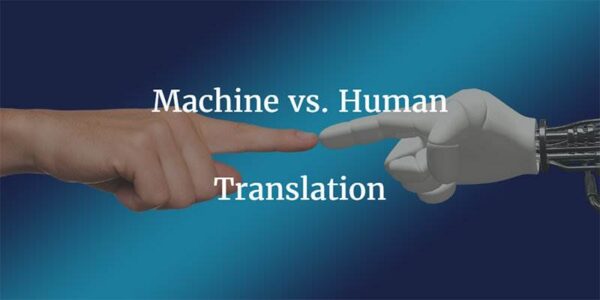An Unbiased Comparison Between Machine And Human Translation

The translation industry before 1990 involved only humans dealing with long piles of papers and translating every piece of document word by word. Well, this type of approach towards translation though slow, was the ultimate technique. Since the translation industry went through a transformation after the year 1990 with the introduction of machine-based translation, it brought in many changes to the world of translation and soon both humans and machines learned how to co-exist in the translation industry. With expert translators operating the digital prowess of the current world, we now have superlative translation services.
Even the certified translation services of the modern era can’t think of getting their speed amped up without using a mix of both human and machine-based translation. There are many people who have started thinking that the influx of machine translation in certified translation services is slowly eating away the importance of humans in the translation industry, but the truth is just the opposite of this common misconception.
By incorporating machine-based translation, humans have become more productive and effective at translating any type of content and that too in less time. So, we can say that most of the rumors regarding machine-based translation in certified translation services are because of the lack of knowledge.
This is why, in this blog post, we will go through an unbiased comparison of both machine and human-based translation for certified translation services.
What is machine-based translation?
Each and every type of translation that is done by a computer is known as machine-based translation. It is one of the simplest forms of translation in which the user has to choose both the base and the target language. But we are not talking about the free tool that you get through Google search, we are talking about AI-powered translating platforms that are more commonly known as neural machine translators.
If machine translation was enough to deal with each and every type of certified translation service then most of the popular translation companies would have got rid of 90% of their workforce, but that’s not the case. You should know that document translation services are not about translating the document word by word, otherwise humans would have been completely replaced by machines in the translation industry. The efficiency in translation and the need for accuracy is something that can never be replaced with automated translation services.
The pros of machine translation
Speed
One of the biggest advantages of machine translation is speed. It doesn’t matter how experienced or skilled a translator is, he or she will never be able to surpass or even match the speed of machines. You will be surprised to know that machines can translate a document of 100 pages in less than 10 minutes and that type of speed can never be achieved by humans. However, the thing to note here is that accuracy takes a couple of steps back without human guidance hence the speed will be of no use if the machine is not properly guided by an expert translator.
The power of automation and AI
The automated translation process completely depends on AI and that’s why it can deal with more than 101 types of repetitive jobs in the translation process like revising content, reviewing content, and assigning tasks. This can save lots of time for companies providing document translation services. Now, it can only be achieved with a human working upon guiding the automated process with proper inputs.
Less costly
You can’t ignore the fact that machines will always be less costly than humans. However, we can only wish for a machine that is able to replace the human requirement in the translation process completely.
The cons of machine translation
Not 100% reliable
If machine translation is never verified by a human then the outcome can be really sloppy as even with so much advancement, you can’t rely on machines 100%. This is why human intervention is necessary even after choosing machine translation.
Not suitable for high priority content
If you are looking forward to translating content related to marketing that has the potential of sales then you will need to be 100% accurate. If a customer is going to find errors in the translated piece then there are minimum chances that he will make any purchase, and with MT, you can’t be 100% accurate.
Machines lack context
If you are translating any piece of a document then you just can’t ignore the importance of context and this is what machines lack even in the modern era. Even with so much development, modern-day machines are not able to identify hypersensitive linguistic subtleties of contextual details. This is one of the biggest drawbacks of relying on machines for translation.
The pros of human translation
Better quality
Humans can make a translated piece of content look fluent and natural and this is why the quality of translation service achieved by humans can’t be matched with machines for the next 10–20 years. A human working on a piece of content can rearrange the words in order to suit the target audience, but this can never be achieved by a machine.
Language expertise
When it comes down to an experienced native translator then their expertise of both languages can be used to make the piece of content fit in like a glove in the need of the market that you are targeting. And this is what all MTs out there lack.
Cultural sensitiveness
Cultural sensitiveness is something that is followed around the whole world and this is why it needs to be kept in mind while translating any piece of document. But it doesn’t matter how advanced or smart the modern-day machines become, they will never be able to deal with cultural sensitivity for the next 10–15 years and that’s where humans play an important role.
The cons of human translation
Slow
It’s true that human translation is a slow process and if you are running a translation company that provides world-class translation services then you just can’t rely on humans. But, coupled with a handy translation service software, they can easily breeze through your project and make it accurate and efficient in no time.
Expensive
Hiring, training, and managing a human for translation is surely costlier than using a machine for the same purpose but also indispensable. Our workforce is what makes us and same goes for translation industry.
After going through the pros and cons of both human and machine-based translation, we can say that they both need to coexist in order to improve the translation services provided by reputed translation companies. Solely relying on one type of translation will never work in the modern era.







